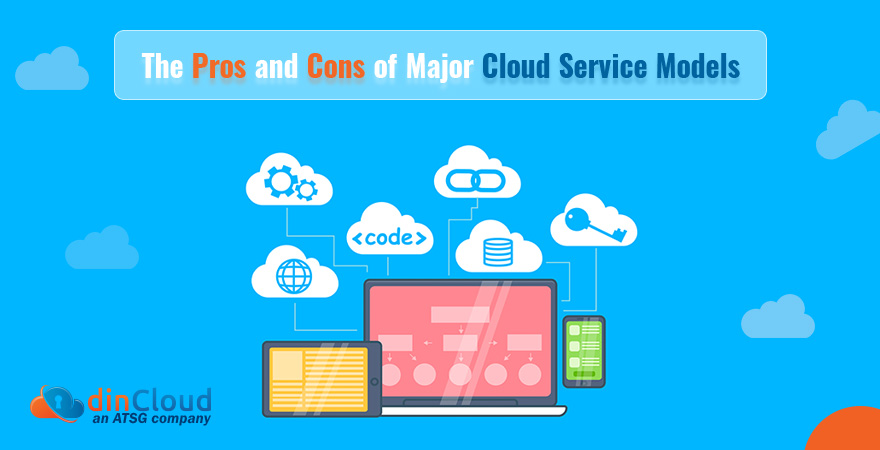The raging Covid-19 pandemic has acted as a catalyst for speedy digitalization across organizations. The level of flexibility, scalability and versatility that is warranted by today’s uncertain circumstances is offered by few technologies like Cloud Computing.
While the adoption of cloud computing services is constantly on the rise, there are multiple cloud service delivery models. Each of these models comes with its own set of pros and cons, and every enterprise needs to weigh them before taking the leap.

In this post, we will be focusing on the pros and cons of three major cloud service delivery models. These include Software as a Service (SaaS), Platform as a Service (PaaS) and Infrastructure as a Service (IaaS).
Related: How Does the Cloud Enable Analysis and Forecasting from Data Sets?
Software as a Service (SaaS)
In this cloud service delivery model, the vendor provides fully ready to use enterprise software or applications over the Cloud. These cloud based software / apps / solutions are both developed and hosted over the SaaS provider’s own infrastructure.
Pros of SaaS
- This is an ideal cloud service delivery model for small to medium sized enterprises (SMEs). They get access to best in class software solutions.
- SaaS models are easy to deploy and manage, and do not require high level in-house IT skills for their deployment or management.
- No infrastructure or setup related costs are involved. All that is required is purchase of licenses and the enterprise is billed on the basis of the number of users.
- SaaS solutions are readily available and accessible through a wide range of end user devices. All that is required is a decent internet connection.
Cons of SaaS
- SaaS solutions impose integration related limitations on the deploying enterprises. Nearly all aspects of the solution are controlled by the SaaS provider.
- The providers of SaaS solutions leave little to no room for customization, as the solution is pretty much standardized for all the end users.
- SaaS solutions do impose governance and security related limitations on enterprise data, as these aspects are in the hands of the SaaS provider.
Platform as a Service (PaaS)
This cloud service delivery model provides developers with all the requisite development environments, tools, APIs and scripts etc. that are hosted over the Cloud. This in turn gives developers the ability to quickly roll out, test, debug and deploy enterprise applications.
Related: The Impact of Cloud Computing on Technology Evolution
Pros of PaaS
- PaaS fast tracks the development, testing and deployment life cycle of various enterprise applications and solutions.
- As most PaaS platforms offer support for multiple programming languages, developers are free to use the language and tools that deliver the best performance.
- Being hosted over the Cloud, PaaS environments are highly suitable for remote collaboration among developers, as each user has real time access.
Cons of PaaS
- The development environments, and the data of enterprises that ultimately go for PaaS, are stored at the vendor end. This raises data security and privacy concerns.
- At times, there can be issues related to the infringement of intellectual property, which may act as an entry barrier for top notch developers out there.
- While a solution developed over PaaS might be very capable, there may be integration related challenges at the time of deployment, requiring further customization.
Infrastructure as a Service (IaaS)
Under the IaaS model, specialized Cloud Service Providers (CSP) like dinCloud give enterprises access to virtualized computing resources like storage, network, processing, or a combination of these.
Related: The Future of Edge Computing and the Problems it Solves
Pros of IaaS
- Deploying enterprises are treated with instant scalability, whether its scaling the virtualized resources up or down, with changing business needs.
- IaaS providers offer a robust Business Continuity (BC) posture, mainly due to a large footprint of highly connected data centers.
- Leading IaaS providers like dinCloud have both the infrastructure and in-house skills as well as expertise to deploy, manage and secure IaaS environments.
Cons if IaaS
- At times, the lack of in-house IT skills on the part of deploying enterprise can delay the implementation timelines.
- While IaaS providers like dinCloud have multi layered security controls in place, the fact that data is stored at the cloud provider’s end may raise compliance concerns.
- Unlike dinCloud, which has a flat rate pricing model for its IaaS solutions, there could be hidden costs in the case of some IaaS solutions.
Conclusion
When it comes to cloud service delivery models, the list is much longer. In this post, we have covered only the three most common cloud service models. Whether to go for SaaS, PaaS, or IaaS will depend on the unique preferences of every deploying enterprise.
Contact dinCloud for leading IaaS solutions that are secure, reliable and scalable on the fly, as and when your needs evolve.


